Dr. Ambedkar’s Library: What He Read, Why It Mattered
Dr. Bhimrao Ramji Ambedkar possessed one of the world’s largest private libraries at the time of his death in 1956, containing over 50,000 volumes that reflected an intellectual appetite as vast as his social vision. This extraordinary collection was not merely an accumulation of books but a carefully curated arsenal of knowledge that transformed a discriminated Dalit child into the architect of India’s Constitution and a revolutionary thinker whose ideas continue to shape democratic discourse worldwide. Understanding what Ambedkar read, how he read, and why his reading mattered reveals the intellectual foundation beneath one of modern India’s most transformative figures. roundtableindia+2

Intellectual Influences in Ambedkar’s 50,000-Book Library by Category
The Architecture of an Intellectual Revolution
Dr. Ambedkar’s approach to reading was systematic, voracious, and purposeful. According to his personal secretary Nanak Chand Rattu, Dr. Ambedkar once read 8,000 pages in just six days, demonstrating not only his extraordinary capacity for absorption but his methodical approach to knowledge acquisition. This was not casual reading but intensive scholarly engagement with texts that would provide him the intellectual tools to challenge millennia-old systems of oppression. globalambedkarites+1
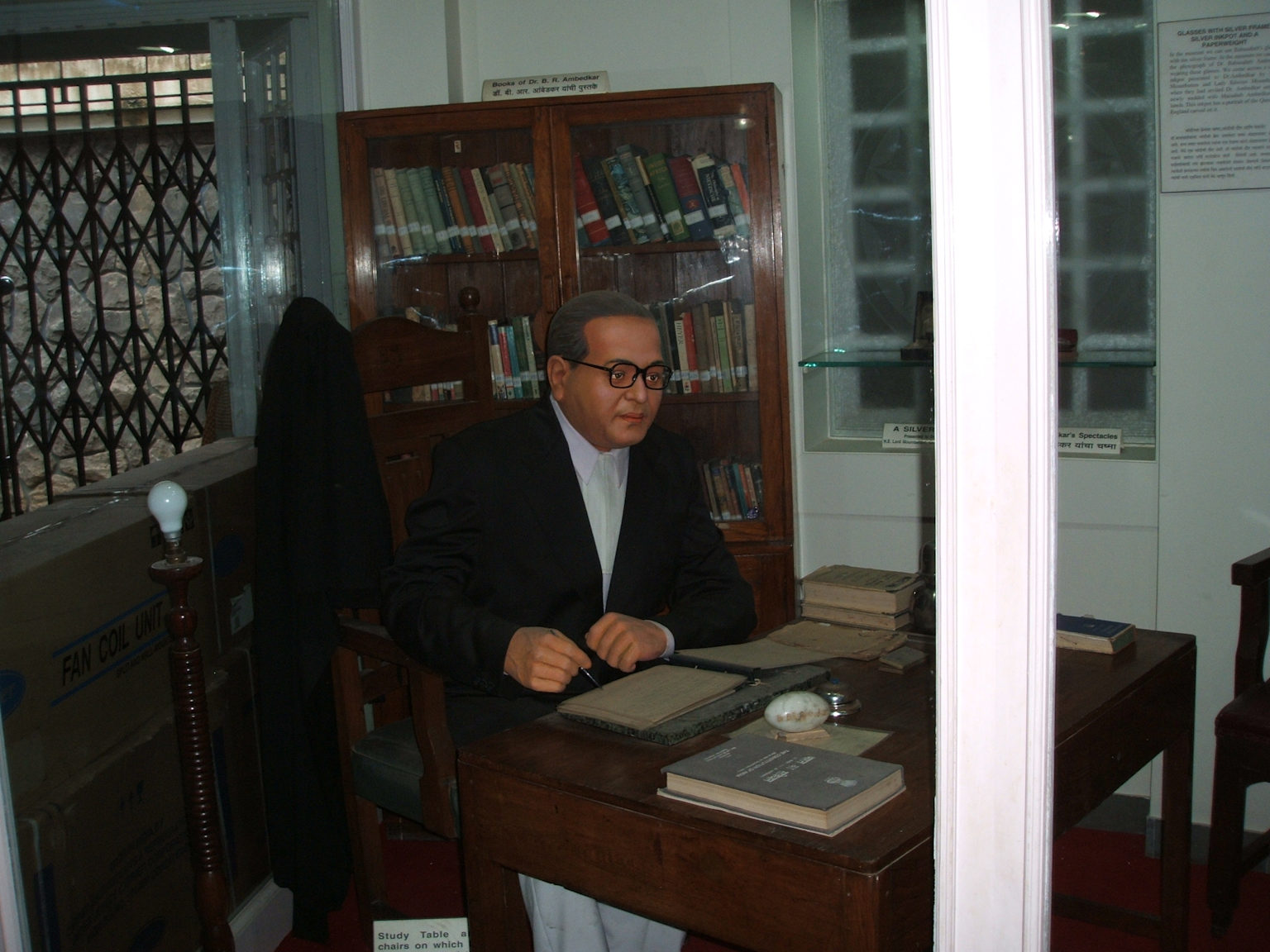
A wax statue of Dr. B. R. Ambedkar at his study table surrounded by his personal library, highlighting his intellectual environment and reading habits commons.wikimedia
His library at Rajgruha in Mumbai, built specifically to house his growing collection, became a pilgrimage site for intellectual seekers. The house itself was designed around the library, with two floors dedicated entirely to books and study space, reflecting Ambedkar’s understanding that knowledge was not decoration but armament in the battle for social justice. Visitors described walking through corridors lined floor-to-ceiling with books in multiple languages: English, Sanskrit, Pali, German, French, and others. roundtableindia+3
The Pragmatist Foundation: John Dewey’s Lasting Influence

Dr. B. R. Ambedkar reading and studying at his desk, reflecting his deep engagement with knowledge and intellectual pursuits forwardpress
The most transformative reading relationship in Ambedkar’s intellectual development was with the works of John Dewey, his professor at Columbia University from 1913-1916. Ambedkar described this influence decades later: “I owe all my intellectual life to him. He was a wonderful man”. The impact was so profound that Ambedkar reportedly transcribed every word of Dewey’s lectures, telling friends that if Dewey died suddenly, “I could reproduce every lecture verbatim”. forwardpress+2
Dewey’s pragmatist philosophy provided Ambedkar with a systematic framework for social reconstruction that emphasized experiential learning, democratic participation, and the possibility of transforming social institutions through rational inquiry. This intellectual foundation became evident in Ambedkar’s later methodology: his insistence on testing ideas against lived experience, his belief that social institutions could be reconstructed, and his famous slogan “Educate, Agitate, Organize”.lib.purdue+1
Ambedkar’s personal copy of Dewey’s works, bearing his annotations in characteristic red and blue pencils, reveals an engaged reader who didn’t merely absorb ideas but actively interrogated and adapted them to Indian conditions. His marginalia shows particular attention to Dewey’s concepts of “creative democracy” and the role of education in social transformation, themes that would become central to Ambedkar’s own philosophy. roundtableindia+2
Economic Theory and Monetary Policy
Ambedkar’s economic reading was both extensive and influential, culminating in his doctoral dissertation “The Problem of the Rupee: Its Origin and Its Solution” at the London School of Economics. His library contained comprehensive collections of classical economists including Adam Smith, David Ricardo, and John Stuart Mill, but he engaged critically with their theories, particularly their assumptions about free markets and social mobility. rediff+3
His reading in monetary theory was so sophisticated that when he presented evidence before the Royal Commission on Indian Currency and Finance in 1926, each member held a copy of his 257-page work. The thesis, which influenced the later establishment of the Reserve Bank of India, demonstrated how his voracious reading in economics translated into practical policy recommendations that challenged imperial economic arrangements. themooknayak+1
Ambedkar’s economic library also included extensive holdings in Marxist literature, acquired during his Columbia years when he took five courses on Marx and socialism under Vladimir Simkhovitch. However, his later experience with Indian Marxists who dismissed caste oppression as secondary to class struggle led him to reject orthodox Marxism, and notably, no Marx books appear in his surviving library. This intellectual journey—from engagement to critical rejection—exemplifies Ambedkar’s discriminating approach to reading. indianhistorycollective
The Comparative Religion Project

Evolution of Ambedkar’s Personal Library (1913-1956): From 2,000 to 50,000 Books
Perhaps the most ambitious aspect of Ambedkar’s reading was his systematic study of comparative religion, occupying an estimated 15,000 volumes in his library. This was not academic curiosity but an urgent practical question: which religion could provide dignity and equality to India’s oppressed communities? As Anupama Rao notes, “Ambedkar tested every big and small, old and new religion available to Indians, trawled the texts and tenets of Hindus, Buddhists, Muslims, Sikhs, and Christians”. roundtableindia+3
His approach was methodical and comparative. He studied the Bible, particularly focusing on the relationship between Christianity and slavery in America, concluding that “Christianity was not enough to end the slavery of the Negroes in the United States”. His investigation of Islam led him to describe it as “a close corporation” that maintained distinctions between Muslims and non-Muslims. His examination of Sikhism was abandoned when he discovered that conversion would cost his community reserved parliamentary seats. wikipedia
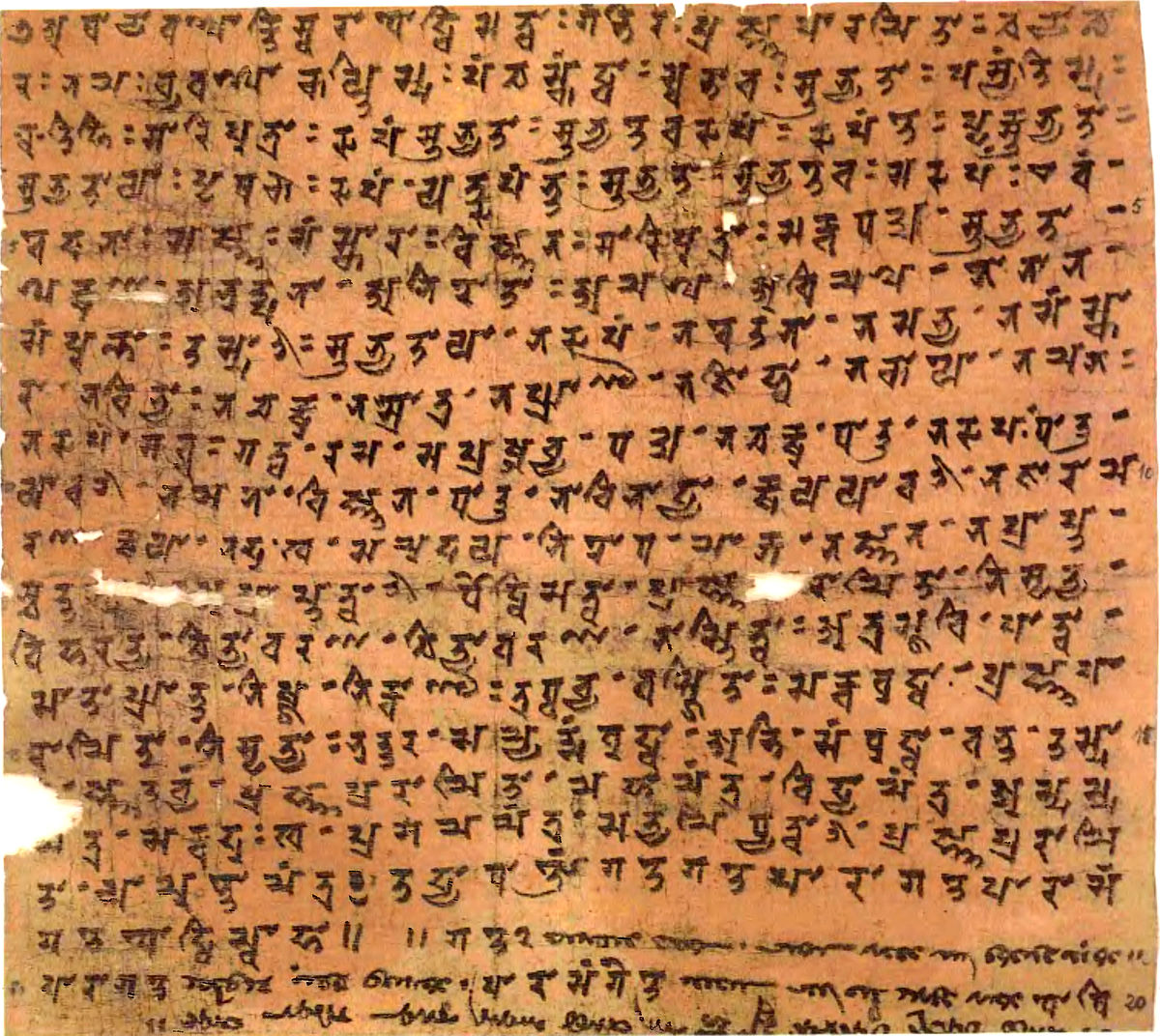
Ancient Sanskrit Buddhist manuscript illustrating traditional Buddhist literature wikipedia
Buddhism emerged from this comparative study as offering the most rational and egalitarian alternative. His library contained extensive collections of Buddhist literature in Pali, Sanskrit, and English translations, including rare manuscripts and commentaries. One book that survived his journey from Columbia to India was Mrs. Rhys Davids’ “Buddhism: A Study of the Buddhist Norm,” inscribed with both “Columbia Varsity, New York” and “Bombay, India,” symbolizing the continuity of his Buddhist interests. indianhistorycollective+1
The Critical Examination of Hinduism
Ambedkar’s library contained perhaps the most comprehensive private collection of Hindu texts in modern India, but these were tools for deconstruction rather than devotion. His systematic reading of the Vedas, Upanishads, Puranas, and Smritis was aimed at exposing what he saw as the intellectual foundations of caste oppression. wikipedia+2
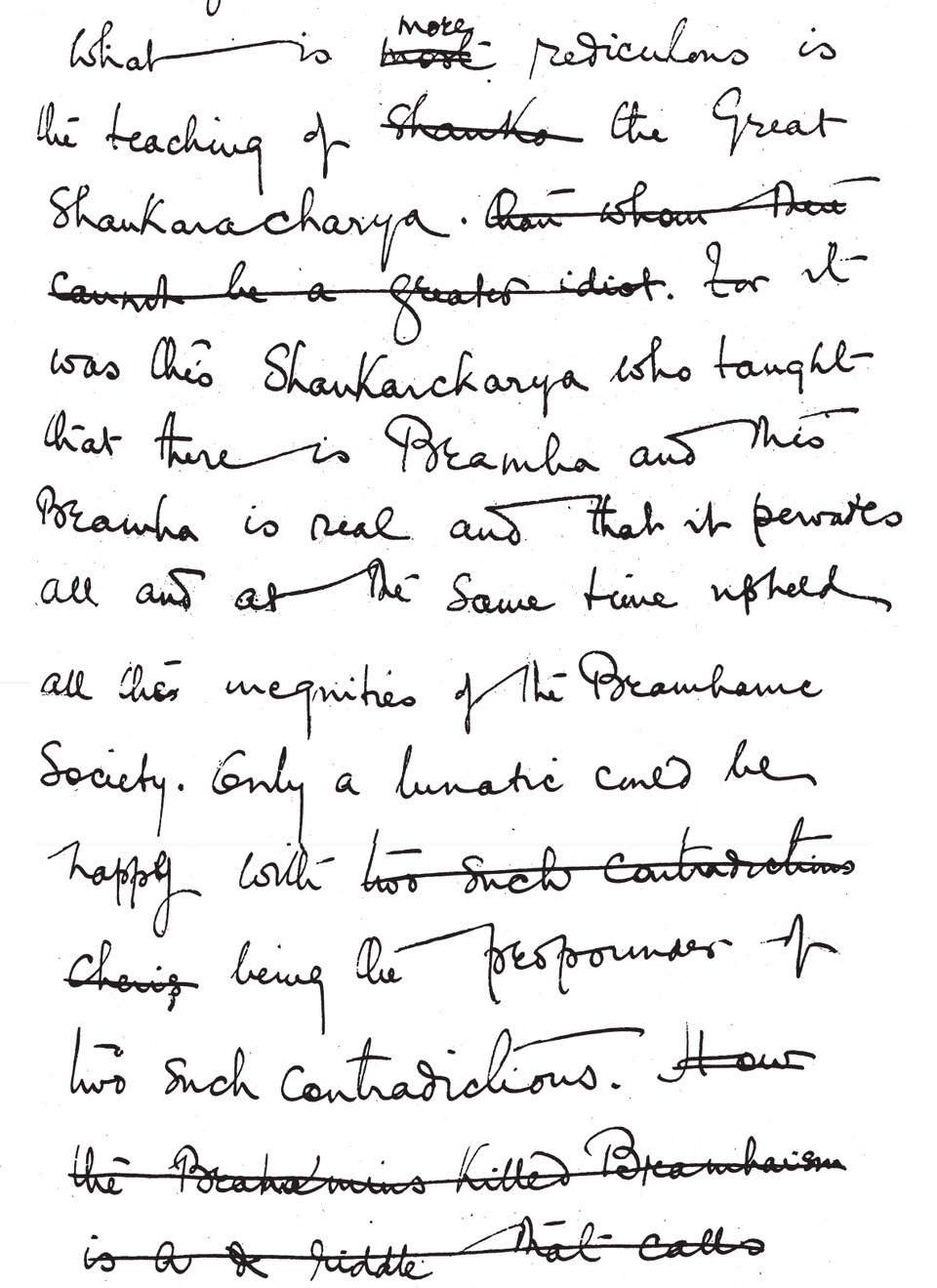
Handwritten note by B.R. Ambedkar on Shankaracharya’s teachings and Brahman, illustrating Ambedkar’s deep engagement with Hindu philosophy and his critical thinking process commons.wikimedia
His methodology is evident in “Riddles in Hinduism,” written between 1954-1955, where he poses systematic questions about Hindu texts and practices based on his extensive reading. The work demonstrates his mastery of Sanskrit literature, quoting extensively from primary sources to challenge orthodox interpretations. His approach was that of a skilled prosecutor building a case, using the tradition’s own texts to expose internal contradictions and moral failings. forwardpress+3
Ambedkar’s annotations in Hindu texts reveal a critical reader who marked contradictions, highlighted problematic passages, and traced the historical development of discriminatory practices. His reading notes show particular attention to how texts were later interpolated and modified to support Brahmanical authority, demonstrating his understanding that religious texts were historical documents subject to human manipulation. roundtableindia+2
The Methodology of a Revolutionary Reader
Annotation and Analysis
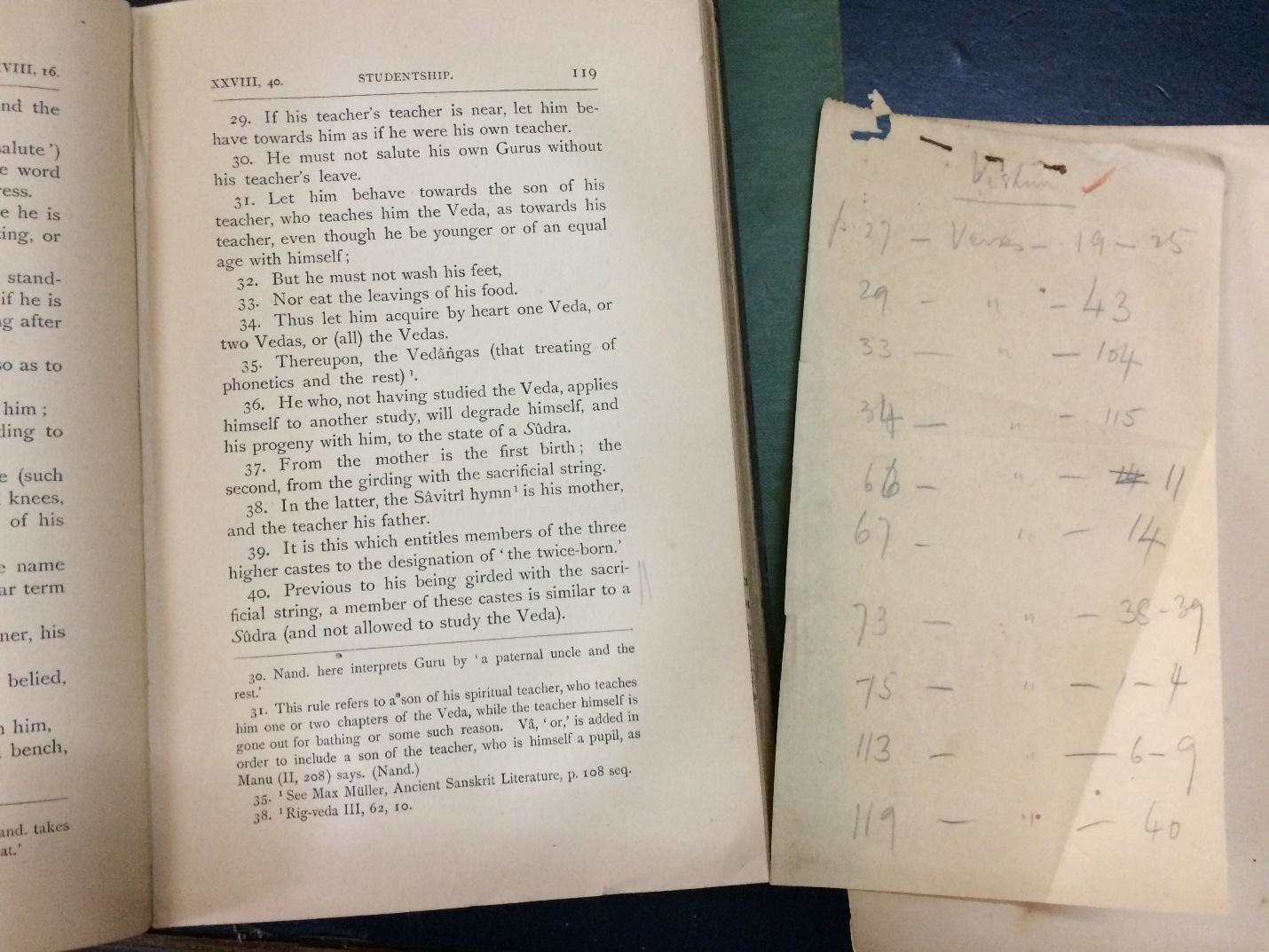
Open page from an old book on studentship and a handwritten note with page references possibly related to reading or annotations navayanapragmatism
Ambedkar’s reading was active and analytical, characterized by extensive marginalia in his distinctive red and blue pencils. Scott Stroud, who has studied Ambedkar’s annotated books at Siddharth College, describes finding volumes marked with “characteristic pencil annotations” that reveal a reader constantly in dialogue with texts. These annotations weren’t merely notes but evidence of an intellectual process that challenged, questioned, and synthesized ideas across disciplines. roundtableindia+1
His approach to reading was systematic rather than casual. He would often read multiple works on the same subject, comparing interpretations and building comprehensive understanding before moving to synthesis and critique. This methodology is evident in his major works, which demonstrate not only broad reading but sophisticated comparative analysis. serialsjournals+2
Building Intellectual Networks
Ambedkar’s reading created intellectual networks that transcended geographical and temporal boundaries. His library reveals a mind in conversation with thinkers across centuries and continents: ancient Buddhist philosophers, medieval Hindu commentators, Enlightenment theorists, contemporary pragmatists, and modern social reformers. This intellectual cosmopolitanism enabled him to bring global perspectives to specifically Indian problems. academia+2
His reading of Bertrand Russell, for instance, influenced his review of Russell’s “Principles of Social Reconstruction” published in 1918, demonstrating early engagement with contemporary Western social theory. Similarly, his study of American pragmatism equipped him to participate effectively in constitutional debates where he could deploy sophisticated democratic theory against both imperial and nationalist arguments. forwardpress+2
The Tragic Loss and Heroic Recovery
The SS Salsette Disaster
One of the most poignant episodes in Ambedkar’s intellectual journey was the loss of his library during World War I. In 1917, forced to return to India when his Baroda scholarship expired, Ambedkar sent his books and first doctoral dissertation separately aboard the SS Salsette while he traveled on another ship. On July 20, German submarine UB-40 torpedoed the SS Salsette, killing fifteen crew members and sending Ambedkar’s precious collection to the bottom of the English Channel. navayana+1
The loss was devastating—over 2,000 rare books accumulated during three years at Columbia, including his first draft doctoral dissertation, were gone. However, Ambedkar had characteristically insured his books, and the insurance money helped him survive financially during his difficult period in Baroda. More importantly, the loss demonstrated his understanding that books were not possessions but tools, and tools could be replaced. rediff+1
Systematic Reconstruction
Ambedkar’s response to this loss revealed his systematic approach to knowledge building. He methodically began rebuilding his collection, often repurchasing the same titles he had lost. Some books, like Dewey’s works, he bought multiple times as his library grew. This dedication to rebuilding demonstrates that his library wasn’t random accumulation but carefully curated knowledge essential to his intellectual mission. indianhistorycollective+1
The reconstruction was not merely recovery but expansion. By 1931, attending the Round Table Conference in London, Ambedkar acquired books that filled thirty-two boxes, showing how his reading appetite had grown beyond even his Columbia days. This systematic expansion continued throughout his life, culminating in the 50,000-volume collection that made his library one of the world’s largest private collections. wikipedia+2
Reading as Intellectual Armament
The Rajgruha Years: Peak Collection Building
By 1932, Ambedkar’s growing collection necessitated a new home designed specifically around his library. Rajgruha in Mumbai became more than a residence—it was an intellectual fortress where Ambedkar conducted the research that would inform his constitutional work, religious writings, and social reform activities. wikipedia
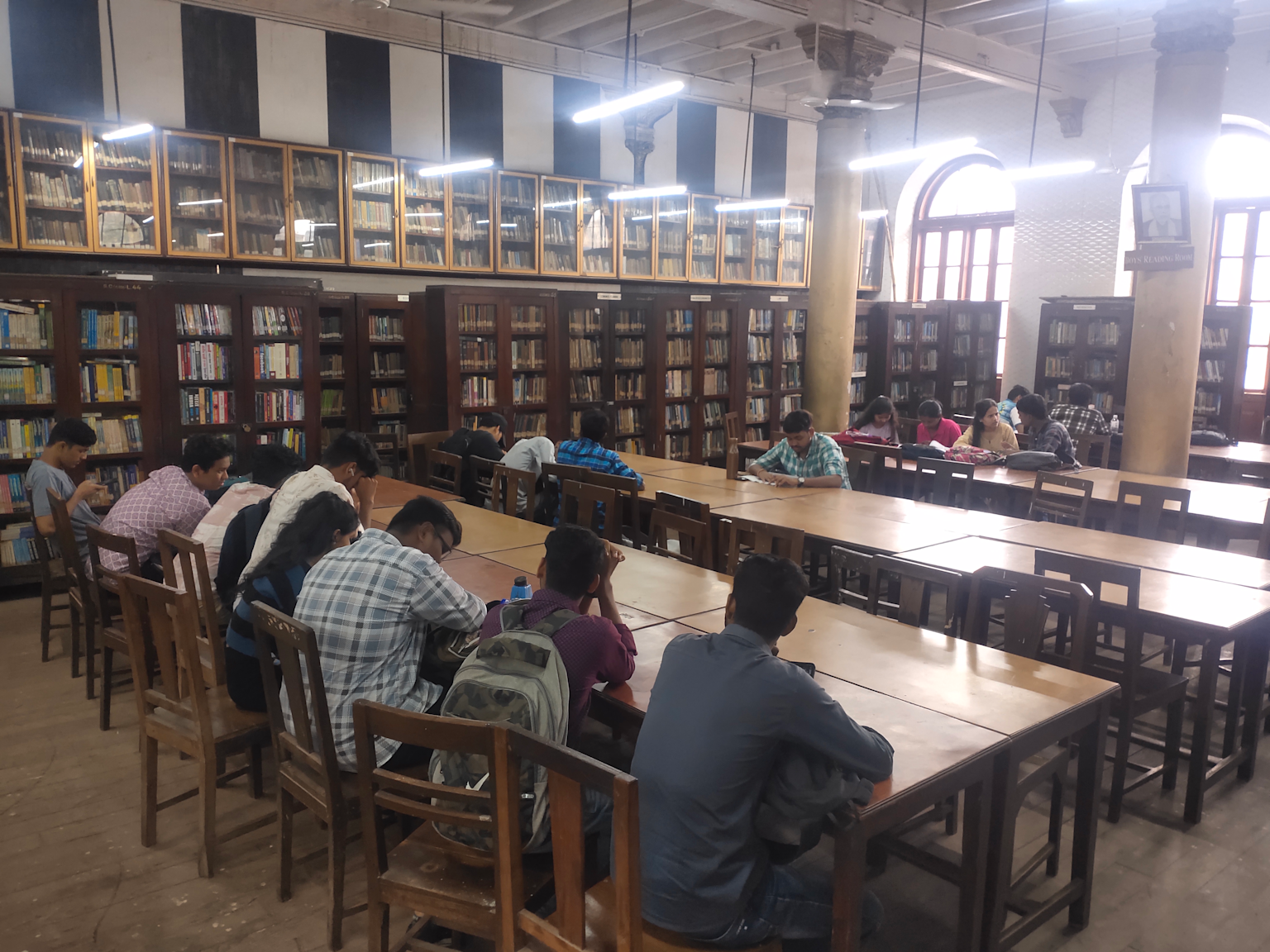
Library interior at Siddharth College Mumbai with students studying among extensive bookshelves siddharthcollege.edu
The house’s design prioritized library space over living space, reflecting Ambedkar’s understanding that knowledge was his most important weapon against oppression. wikipedia
During his peak collection years (1932-1950), Ambedkar acquired an estimated 27,000 additional volumes, bringing his total to around 45,000 books. This period coincided with his most productive intellectual phase: drafting the Indian Constitution, writing “The Buddha and His Dhamma,” and completing “Riddles in Hinduism”. The correlation between his expanding library and his intellectual output suggests that his reading was not passive consumption but active preparation for transformative writing. wikipedia+3
Strategic Reading for Social Transformation
Ambedkar’s library reveals a strategic approach to knowledge acquisition. Unlike collectors who accumulated books for prestige, Ambedkar read to build intellectual capacity for social transformation. His reading lists reflected immediate practical needs: constitutional law when drafting India’s Constitution, comparative religion when considering conversion, economic theory when challenging imperial policies. globalambedkarites+4
This strategic approach is evident in his reading notes and later writings, which demonstrate how he synthesized diverse sources into coherent arguments for social change. His famous work “Annihilation of Caste” draws on readings in anthropology, history, religion, and social theory to build a systematic critique of the caste system. The sophistication of his arguments reflects not just intelligence but the disciplined reading that informed his intellectual development. forwardpress+3
The Living Legacy of Ambedkar’s Library
Preservation and Continuation

Rows of bookshelves in Siddharth College Library, reflecting a rich collection of books that symbolize Ambedkar’s intellectual environment siddharthcollege.edu
After Ambedkar’s death in 1956, significant portions of his library were donated to institutions he had founded: Siddharth College in Mumbai and Milind College in Aurangabad. These institutions recognized the collection’s value not merely as books but as intellectual heritage that could continue inspiring future generations. Today, researchers studying Ambedkar’s marginalia and annotations discover new insights into his intellectual development and methodology. roundtableindia+1
The preservation efforts reflect understanding that Ambedkar’s library was more than personal collection—it was a model of how reading could serve social transformation. Students and scholars who access these collections continue the intellectual tradition Ambedkar established, using reading as a tool for challenging oppression and building more just societies. navayana+2
Reading as Revolutionary Practice
Ambedkar’s approach to reading established a template for intellectual activism that remains relevant today. His demonstration that discriminated communities could master elite knowledge traditions and use that mastery to challenge oppression inspired generations of scholars and activists. His library became proof that no knowledge tradition was beyond the reach of those willing to commit themselves to serious study. globalambedkarites+3
The scale and sophistication of Ambedkar’s reading also challenged stereotypes about intellectual capacity and cultural authority. In a society where educational privilege was monopolized by upper castes, Ambedkar’s vast learning and intellectual productivity demonstrated that brilliance was not caste-dependent but opportunity-dependent. His library stood as material evidence that given access to education and books, any community could produce world-class intellectual achievement. globalambedkarites+3
The Intellectual Method: What Made Ambedkar’s Reading Transformative
Synthesis Across Disciplines
What distinguished Ambedkar’s reading was his ability to synthesize insights across disciplines and traditions. His work demonstrates how economic theory informed his understanding of caste, how pragmatist philosophy shaped his approach to religious reform, and how comparative constitutional study guided his drafting of India’s Constitution. This interdisciplinary synthesis was possible because his reading was guided by practical questions rather than academic boundaries. academia+4
His major works reveal this synthetic methodology. “The Buddha and His Dhamma” combines historical scholarship, religious studies, and social theory to present Buddhism as a rational religion for modern democratic societies. “Riddles in Hinduism” employs anthropological methods, textual criticism, and historical analysis to deconstruct orthodox religious claims. The Indian Constitution reflects influences from comparative constitutional study, democratic theory, and practical experience with discrimination. wikipedia+5
Critical Engagement Rather Than Passive Absorption
Ambedkar’s reading was characterized by critical engagement rather than passive absorption. His annotations and marginalia reveal a reader who questioned assumptions, challenged arguments, and tested ideas against experience. This critical approach enabled him to appropriate useful insights while rejecting problematic elements, as seen in his engagement with Marx, Dewey, and religious traditions. roundtableindia+3
This critical methodology also enabled Ambedkar to read against the grain of texts, finding liberating possibilities in traditions that others might dismiss. His reading of Buddhist texts, for instance, emphasized democratic and egalitarian elements that mainstream Buddhist scholarship often overlooked. His approach to Hindu texts involved excavating evidence of ancient social mobility and challenging later Brahmanical interpretations. theprint+4
Conclusion: The Revolutionary Power of Reading
Ambedkar’s library represents more than an impressive collection of books—it demonstrates the revolutionary potential of systematic reading combined with critical thinking and practical application. His 50,000 volumes were accumulated not for prestige but as intellectual armament for social transformation, providing the knowledge foundation for his successful challenges to caste oppression, imperial policies, and religious orthodoxy. wikipedia+3
The scope and sophistication of Ambedkar’s reading also established new possibilities for intellectual achievement within discriminated communities. His demonstration that thorough mastery of elite knowledge traditions was possible for those excluded from traditional educational privilege inspired generations of scholars and activists who followed his example. His library became proof that intellectual excellence was not caste-dependent but opportunity-dependent. globalambedkarites+3
Perhaps most importantly, Ambedkar’s reading methodology—systematic, critical, synthetic, and practical—provides a model for how knowledge can serve social justice. His example shows that serious reading is not escapism but preparation for engagement, not individual advancement but community empowerment. In an era when access to information has expanded dramatically, Ambedkar’s approach to reading remains relevant for anyone seeking to use knowledge as a tool for social transformation. globalambedkarites+4
The tragedy of the SS Salsette, which temporarily destroyed Ambedkar’s collection, paradoxically demonstrated the resilience of his intellectual commitment. Books could be lost, but the reading habits, critical methods, and synthetic capabilities they had developed remained intact. Ambedkar’s heroic reconstruction of his library after this loss shows that true intellectual achievement lies not in accumulating books but in developing the capacity to engage with ideas transformatively. indianhistorycollective+2
Today, as we face challenges that require similar synthesis of knowledge across disciplines and traditions, Ambedkar’s library offers both inspiration and methodology. His demonstration that reading can be revolutionary practice, that knowledge can serve justice, and that intellectual excellence can emerge from any community remains as relevant today as it was during his lifetime. His 50,000 books were not just a collection but a revolution in progress, one that continues to inspire and guide those who believe in the transformative power of serious reading. askfilo+3
- https://www.roundtableindia.co.in/how-do-we-know-what-ambedkar-read/
- https://en.wikipedia.org/wiki/Rajgruha
- https://globalambedkarites.org/how-many-books-did-dr-ambedkar-read-during-his-lifetime/
- https://www.globalambedkarites.co.uk/2021/02/how-many-books-did-dr-ambedkar-read.html
- https://indianhistorycollective.com/a-young-ambedkar-in-new-york/
- https://navayana.org/blog/2015/12/24/ambedkar-the-bibliophile/
- https://www.forwardpress.in/2017/08/exploring-the-influence-of-russell-on-ambedkar/
- https://docs.lib.purdue.edu/cgi/viewcontent.cgi?article=1648&context=eandc
- https://www.academia.edu/34029122/Exploring_the_Influence_of_Bertrand_Russell_on_Bhimrao_Ambedkar
- https://www.forwardpress.in/2019/06/pragmatist-riddles-in-ambedkars-riddles-in-hinduism/
- https://www.rediff.com/news/report/when-a-german-torpedo-sank-dr-ambedkars-phd-thesis/20250414.htm
- https://tnou.ac.in/wp-content/uploads/2022/12/Dr.-B.-R.-Ambedkar-Thoughts-English_compressed.pdf
- https://www.bbau.ac.in/Docs/FoundationCourse/TM/MPDC405/AmbedkEnlightenedIndia.pdf
- https://en.themooknayak.com/bahujan-nayak/100-years-of-the-problem-of-rupee-dr-br-ambedkars-historic-thesis-shapes-indias-economic-future
- https://www.anushram.com/blog/thesis-of-dr-br-ambedkar/
- https://serialsjournals.com/abstract/25174_4-pawan_mishra.pdf
- https://theprint.in/opinion/why-ambedkar-chose-buddhism-over-hinduism-islam-christianity/237599/
- https://www.theindiaforum.in/article/political-radicalism-ambedkars-spirituality
- https://en.wikipedia.org/wiki/B._R._Ambedkar
- https://en.wikipedia.org/wiki/Riddles_in_Hinduism
- https://www.allaboutambedkaronline.com/post/an-overview-of-of-five-riddles-from-riddles-in-hinduism
- https://www.mea.gov.in/Images/attach/amb/Volume_04.pdf
- https://www.aakashsinghrathore.com/b-r-ambedkar-the-buddha-and-his-dhamma.html
- https://timesofindia.indiatimes.com/readersblog/dinesh-sud/the-fascinating-story-of-dr-br-ambedkar-27216/
- https://en.wikipedia.org/wiki/The_Buddha_and_His_Dhamma
- https://askfilo.com/user-question-answers-smart-solutions/ambedkar-was-a-voracious-readar-justify-3231313832353232
- https://blogs.library.columbia.edu/global-studies/2019/04/15/speaking-truth-to-power-dr-ambedkar-and-columbia-university/
- https://daic.gov.in/library.html
- https://www.ijirmf.com/wp-content/uploads/IJIRMF201611074.pdf
- http://puneresearch.com/media/data/issues/61d84ea51a648.pdf
- https://www.allaboutambedkaronline.com/post/brahminism-vs-buddhism-an-overview-of-revolution-and-counter-revolution-in-ancient-india
- https://library.bjp.org/jspui/handle/123456789/320
- https://www.mea.gov.in/images/attach/amb/volume_03.pdf
- https://drambedkarbooks.com/wp-content/uploads/2009/03/buddha-and-his-dhamma.pdf
- https://www.youtube.com/watch?v=Nnx7_13af7E
- https://www.mea.gov.in/books-writings-of-ambedkar.htm
- https://www.cvs.edu.in/upload/Why%20buddhism.pdf
- https://hinduexistence.org/2021/04/14/hindutva-and-dr-b-r-ambedkar-2/
- https://archive.org/download/riddles-in-hinduism/Riddles%20in%20Hinduism.pdf
- https://www.mea.gov.in/Images/CPV/Volume6.pdf
- https://ruralindiaonline.org/en/library/resource/dr-babasaheb-ambedkar-vol-11-the-buddha-and-his-dhamma/
- https://india.oup.com/product/b-r-ambedkar-the-buddha-and-his-dhamma-9780198068679/





















